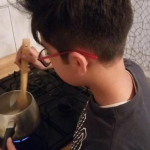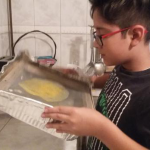PK-56-MA-MA BIOAPLÁSTICO A BASE DE CÁSCARAS DE FRUTA
PK-56-MA-MA BIOAPLÁSTICO A BASE DE CÁSCARAS DE FRUTA
Categoría: Pandilla Kids (3ro., 4to., 5to. y 6to. Año de primaria)
Área de participación: Ciencias de los Materiales
Resumen
Elaborar envases o artículos a base de cascaras de fruta, que puedan ser utilizado por el ser humano. La idea principal es dejar de utilizar artículos desechables que dañen el medio ambiente.
Pregunta de Investigación
¿Cómo se puede crear el bioplástico con cáscaras de frutas y que puede ayudar?Planteamiento del Problema
Elaborar envases o artículos a base de cascaras de fruta, que puedan ser utilizado por el ser humano. La idea principal es dejar de utilizar artículos desechables que dañen el medio ambiente.
Antecedentes
Alguna empresas ecológicas se han tomado a la tarea de fabricar productos con cascaras de fruta para crear el bioplástico.
La naranja es un poderoso antioxidante por la gran cantidad de Vitamina C que contiene.También contiene calcio, magnesio, beta caroteno, ácido fólico, fósforo,potasio, cobre, zinc, ácidos málico, óxalico, tartárico y cítrico.
Objetivo
Obtener un producto plástico a base de productos naturales que no dañen el medio ambiente.
Justificación
Realizar un producto en beneficio del medio ambiente.
Hipótesis
Obtener un plato desechable con cascaras de fruta.
Método (materiales y procedimiento)
- – Mezclar 1 cucharada de glicerina, vinagre, 30 gr. de almidón, 1 taza de agua, hasta disolver todos los ingredientes.
- Licuar las cascaras de fruta con medía taza de agua.
- Llevar a fuego lento ambas mezclas, agregar el colorante vegetal y mover hasta lograr una mezcla gelatinosa.
- Elaborar una base con malla sintética con bordes de madera.
- Colocar la mezcla gelatinosa sobre la base de la malla.
- Dejar secar por un día.
Resultados
Análisis e interpretación de resultados.
¿Qué obtuve?
Obtuve un material moldeable. Liso y plano para dar la forma que se desee, el cual puede ser utilizado como plástico para diversas actividades.
Discusión
Conclusiones
Después de la revisión de la información y mi experimentación, ¿qué aprendí?
Aprendí que con los recursos naturales podemos elaborar productos de utilidad para la vida diaria los cuales serán en beneficio de medio ambiente.
Bibliografía
https://www.academia.edu/22147819/BIOPL%C3%81STICO_A_BASE_DE_LA_C%C3%81SCARA_DEL_PL%C3%81TANO_BIOPLASTIC_MADE_FROM_BANANA_PEEL_RESUMEN
https://www.bioguia.com/ambiente/como-hacer-bioplastico-en-casa-con-cascaras-de-fruta_29282801.
htmlhttps://es.wikihow.com/hacer-biopl%C3%A1stico-f%C3%A1cilmente
PK-56-MA-MA BIOAPLÁSTICO A BASE DE CÁSCARAS DE FRUTA
PK-56-MA-MA BIOAPLÁSTICO A BASE DE CÁSCARAS DE FRUTA
Summary
To avoid the uses of plastics look for bioplastic, to generate a culture on the disposable using other products that do not harm the environment.
Research Question
How can you create bioplastic with fruit husks and what can help?Problem approach
Elaborate containers or articles based on fruit peels, which can be used by humans. The main idea is to stop using disposable items that harm the environment
Background
Some ecological companies have taken on the task of manufacturing products with fruit shells to create the bioplastic.
Orange is a powerful antioxidant for the large amount of Vitamin C it contains. It also contains calcium, magnesium, beta carotene, folic acid, phosphorus, potassium, copper, zinc, malic, oxalic, tartaric and citric acids.
Plastic is one of the materials most used by humanas. It is called plastic materials made up of a variety of organic, synthetic or semi-synthetic compounds, which has the property of being malleable and can therefore be molded into solid objects of various shapes.
Objective
Some ecological companies have taken on the task of manufacturing products with fruit shells to create the bioplastic.
Orange is a powerful antioxidant for the large amount of Vitamin C it contains. It also contains calcium, magnesium, beta carotene, folic acid, phosphorus, potassium, copper, zinc, malic, oxalic, tartaric and citric acids.
Plastic is one of the materials most used by humanas. It is called plastic materials made up of a variety of organic, synthetic or semi-synthetic compounds, which has the property of being malleable and can therefore be molded into solid objects of various shapes.
Justification
Make a product for the benefit of the environment.
Hypothesis
Make a product for the benefit of the environment.
Method (materials and procedure)
1.- Mix 1 tablespoon of glycerin, vinegar, 30 gr. of starch, 1 cup of water, until all the ingredients are dissolved.
2.Liquify the fruit peels with a half cup of water.
3. Bring both mixtures to a simmer, add the vegetable dye and move until a gelatinous mixture is obtained.
4. Elaborate a base with synthetic mesh with wooden edges.
5. Place the gelatinous mixture on the base of the mesh.
6. Let dry for a day.
Results
Analysis and interpretation of results.
What did I get?
I got a moldable material. Smooth and flat to give the shape you want, which can be used as plastic for various activities.
Discussion
After reviewing the information and my experimentation, what did I learn?
I learned that with natural resources we can make useful products for daily life which will benefit the environment.
Conclusions
After reviewing the information and my experimentation, what did I learn?
I learned that with natural resources we can make useful products for daily life which will benefit the environment.
Bibliography
Bibliography.:
https://bricolaje10.com/bioplasticos/
https://www.bioguia.com/ambiente/como-hacer-bioplastico-en-casa-con-cascaras-de-fruta_29282801.html
https://es.wikihow.com/hacer-biopl%C3%A1stico-f%C3%A1cilmente
https://www.ecologiaverde.com/como-hacer-plastico-biodegradable-con-maicena-1535.html















